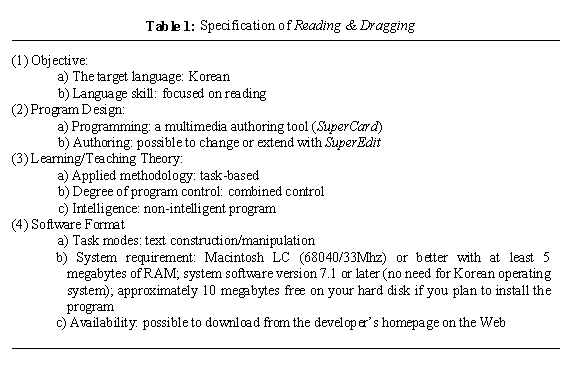
Reading & Dragging:
The development and use of courseware
Introduction
Research on reading in Computer-Assisted Language Learning (CALL) environments has indicated that the computer can be used effectively in the learning/teaching of reading (Garrett, 1991; Nyns, 1988; Son, 1997; Wyatt, 1989). Herron and Moos (1993) praise electronic media in foreign language and literature classrooms and urge language teachers to explore electronic technologies creatively. Comparing it with paper texts, Cobb and Stevens (1996) state that on-screen reading offers "overt interactivity" (p. 121). Specifically, Biber (1992) and Olson & Wise (1987) argue that CALL applications can provide interaction between text and readers through the facility of being able to hear words and sounds. Thus, CALL provides interactive reading activities which may contribute to the improvement of reading skills, while allowing learners to work individually at their own pace.
There has been much need for developing CALL applications that would support reading instruction in many language courses. A number of researchers (e.g., Marsh, 1983; Son, 1995; Wyatt, 1989) agree that the development of adequate software for reading is crucial for CALL. As observed by Nyns (1988) about ten years ago, most CALL applications are still used for drill and practice, cloze type exercises or multiple-choice questions although several hypertext-type programs (e.g., Evans, 1993; Hult, Kalaja, Lassila & Lehtisalo, 1990) incorporating text, graphics and sound have been produced for language learning purposes. Cloze type exercises, in particular, seem popular in the CALL classroom because they can be implemented more effectively on the computer-based form than on the paper-based form and CALL developers including language teachers can create the exercises easily in a variety of ways. Taking a similar position, Cobb and Stevens (1996) praise the use of text manipulation activities to develop reading skills in a second language, assuming that text manipulation such as cloze exercises which use authentic and ungraded text can engage students in reading at higher cognitive levels.
This paper describes a computer program developed for students learning Korean as a foreign language and reports on a small study concerned with the evaluation of the program. It presents some practical considerations for the development and use of the program called Reading & Dragging and attempts to answer questions about the students' behaviour during the computer work and their reactions to the computer program, while investigating the students' attitudes toward computer-assisted reading activities.
Reading tasks in CALL research
CALL researchers have frequently adopted reading tasks embedded in reading courseware in order to observe and describe CALL activities. For example, Windeatt (1986) chose a computer program called Clozemaster, which provides cloze versions of texts, and recorded his twelve students on videotape while they worked on two reading tasks in CALL form and non-CALL form. He reported that his subjects used different reading strategies in the two tasks but that there were no substantial differences in the interaction among students in CALL and non-CALL exercises. Piper (1986) also video-recorded three groups of three students' conversations to investigate the possible spin-off from three text-based CALL tasks in three computer programs: Clozemaster, Vocabulary, and Copywrite. She found that the language functions that learners used when working in groups were very limited in range and number. Edmondson, Reck, and Schroder (1988) used a text-manipulation program called Shuffler, their version of Jumbler, to look into the strategies employed by nine secondary level students of a German school doing a combined, jumbled or shuffled sentence exercise. They recorded the students' verbal reports on audiotape and the keyboard workings on the computer disk and described different strategies based on a strategic analysis of the students' shuffling procedures. While suggesting that cloze is particularly suitable for text manipulation, Stevens (1996) explored how students approach text manipulation activities in two CALL programs, Hangman-in-Context and SuperCloze. He found that about 54 different students working in self-access mode tended to abuse help features and that there was an element of window-shopping in the use of the programs.
With regard to the evaluation of computer-assisted reading instruction, Wisher (1986) examined
an approach to teaching reading comprehension by using three instructional
exercises including sentence arrangement tasks, paragraph organization tasks and
missing word tasks. In a comparison of computerized
reading instruction with traditional classroom instruction in matched groups, he found that both groups improved literal comprehension, but the computerized group decreased the needed instruction time. Kleinmann (1987) chose twenty commercial reading programs such as Advanced Reading Comprehension, Clozemaster, Speed Reader and Word Attack in a study of the effectiveness of computer-assisted instruction (CAI). He found no significant differences between CALL groups that used the programs and traditional groups that did not have a CAI component. He concluded that this result was because the drill-and-practice nature of selected CALL software failed to develop higher-level reading comprehension skills.
The program
DesignCALL programs can enhance reading activities by providing various kinds of reading tasks. In terms of types of reading tasks, three interactive levels can be discussed: (1) recognition; (2) understanding; and (3) application. Tasks in the recognition stage include kinds of vocabulary exercises such as identifying alphabet letters and single words. In the understanding stage, tasks are related to the reception of background information, inferring meanings of phrases and sentences, using grammar references, translating texts, answering comprehension questions, etc. On the other hand, the application stage adapts integrative tasks such as speed reading, skimming and scanning. Working on these assumptions, the Reading & Dragging program endeavours to present certain kinds of text construction and manipulation exercises with immediate feedback in the recognition and understanding levels.
Reading & Dragging was designed to provide students with computer-assisted Korean reading exercises utilising the mouse-drive movement on the computer. Table 1 shows major design features of Reading & Dragging. A multimedia authoring tool for the Macintosh, SuperCard, was used for designing the program. It is a software product for delivering interactive and content-rich multimedia applications. It combines two metaphors for building software: the Macintosh metaphor of window and pull-down menu as a way of navigating through a program; and the metaphor of cards and stacks of cards as a way of storing information (Allegiant Technologies, 1994).

Three types of
computer-assisted Korean reading practice were developed using the computer
software necessary for their presentation. Students' linguistic
guesses at the level of words, phrases, and sentences were generated. First, the word
selection
exercise used a kind of cloze procedure in which students would choose and drag a missing word from a controlled set of words and fill in a given sentence. Second, the matching phrases task required students to drag and match a phrase with another phrase in order to make an appropriate sentence. Third, the sentence arrangement task asked students to rearrange jumbled sentences into a proper order in a target dialogue. To integrate the CALL program into the existing curriculum, most of the Korean words, phrases and sentences in Reading & Dragging were selected from the course textbook, Learning Korean: New Directions 3 (Buzo & Shin, 1995), and revised for the reading exercises.
Interface
Reading & Dragging starts with a symphonic sound as soon as the title appears. The first screen, Figure 1, automatically moves to the menu screen, Figure 2. The main menu has four units to choose from and each unit has three exercises in different screens.
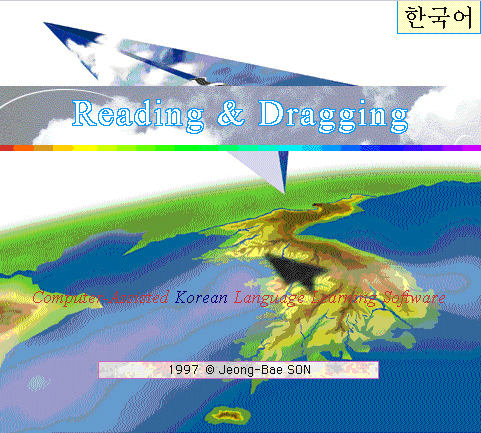
Figure 1: The start-up screen of Reading & Dragging
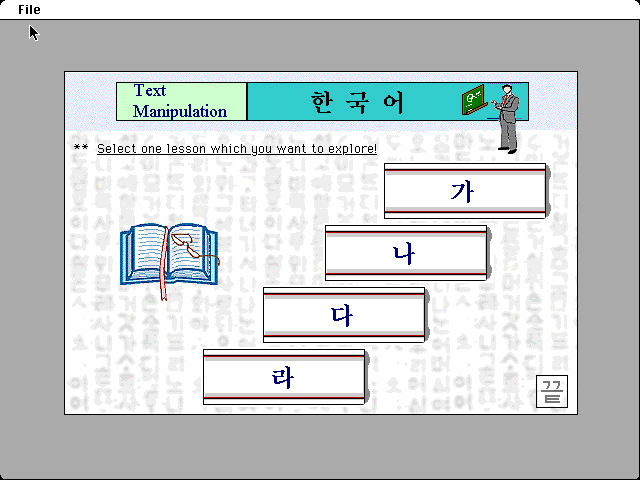
Figure 2: Main menu of Reading & Dragging
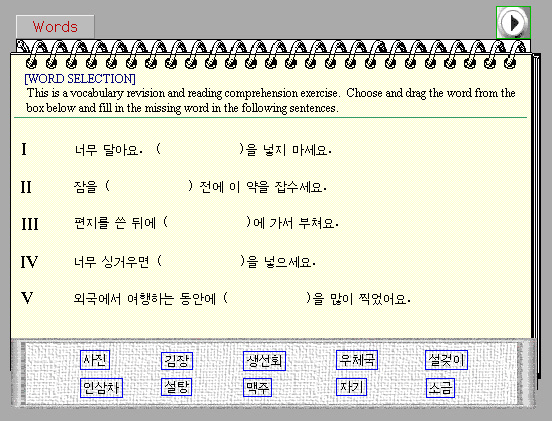
Figure 3: An example of a word selection task

Figure 4: An example of a matching phrases task
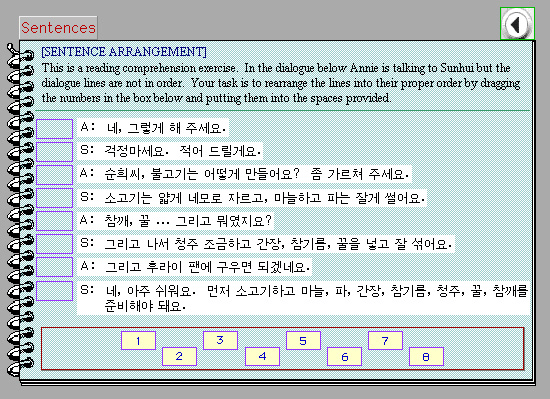
Figure 5: An example of a sentence arrangement task
Figures 3, 4, and 5 show screen layouts of three reading tasks employed in Reading & Dragging. In the section of the word selection seen in Figure 3, students are asked to choose and drag the word from the box and fill in the missing word in the given sentences. Similarly, in the section of the matching phrases seen in Figure 4, students are asked drag and match the phrase on the left with the phrase on the right to make an appropriate sentence in Korean. In the section of the sentence arrangement seen in Figure 5, the students' task is to rearrange the lines into their proper order by dragging the numbers in the box and putting them into the spaces provided. Throughout each of the three tasks, if students put a wrong answer in the sentences, a warning is sounded and the word they dragged returns to the original place in the box. If they get a right answer, the sentence they answered is pronounced in the digitized voice of a native speaker in the word selection and matching phrases tasks. In the sentence arrangement task, they can hear the sound of the sentences by clicking the sentence they want to hear before they drag the numbers into the small boxes.
The study
AimsThe study mainly aimed to investigate the students' reactions to the program Reading & Dragging. In doing so, there were two specific aims of this investigation. The first was to see how the students used the program and the second was to find out what they thought about the program and how they felt about computer-assisted reading activities in general.
Method
Subjects
English, for 3 it was Japanese, and for 1 it was Chinese. The majority of the students were 18 to 20 years old, the youngest being 18 years old and the oldest 25 years old. All of the students had already had previous experience with the computer, especially for word processing, either at home or at school. The students had also used simple self-access CALL materials throughout their first year Korean course.
Instruction
In the Korean
course, there were 8 contact hours per week comprising a one-hour lecture and
seven tutorial hours. A one-hour reading session was one of the seven tutorial
hours that the students were required to attend each week. The study was
conducted at the four reading sessions for four weeks during the first semester
(from February to June) of 1997 in a computer lab where there were 15 Macintosh
computers. One session consisted of pre-computer work, computer work, and
post-computer work. During the pre-computer work, the teacher gave the students
background information on the reading material and new vocabulary information.
Throughout the computer work, the students had instructional exercises with the
computer program. Following this, the students had a time to review key points
of the lesson and to answer some translation questions asked by the teacher
during the post-computer work.
Reading tasks
Three types of
reading tasks were employed in the program Reading
& Dragging: (1) word selection; (2) matching phrases; (3) sentence
arrangement.
Worksheets
For the
students' review, paper-based worksheets were prepared to accompany each of the
four units. These contained written reading tasks with the same contents as
those of the computer programs.
Observation checklist
During the
computer sessions, the teacher observed how the students dealt with the tasks
on the computer and checked some points such as cursor movement and error
handling by using a checklist.
Questionnaire
A questionnaire
was administered to document the students' attitudes toward the CALL program at
the end of the last computer session. On the questionnaire, the students were asked
to rate ten items by a 5-point scale (1 strongly agree, 2 agree, 3 uncertain, 4
disagree, 5 strongly disagree) and to provide comments on the computer
work.
Results
This section presents the results of the two sets of data collected during the study, an observation checklist and a questionnaire. Table 2 shows the data collected from the observation. Among the four reading sessions, the last two sessions were observed and recorded on an observation checklist in the form of checks on what the students did during the computer work.
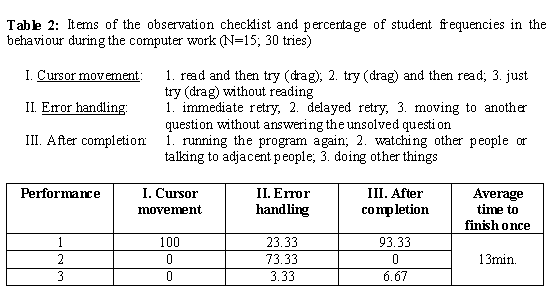
As seen in Table 2, all of the students read each sentence first and then dragged possible answers when working with the program. On the question of error handling, most of the students re-tried after taking some time to read or think when they made a mistake in answering the questions. About 93% of the students made the program run again after they had completed the three tasks once. They took about 13 minutes on average (from 10 minutes to 15 minutes) to finish the tasks. It seemed that they tried to do the tasks in a sound way.
Appendix A shows the data collected from the questionnaire. Questions 1, 2 and 3 were designed to elicit student reactions to general impressions on using computers. Results indicate that the students seemed to appreciate the use of the computer for learning Korean. Questions 4, 5, 6 and 7 relate to the efficiency of the computer program. The students seemed to consider the program useful although they thought they were not much more motivated by the tasks presented in computerised form than by those in non-computerised form. Questions 8, 9 and 10 asked the students to indicate whether they would like to use more computer-assisted language learning materials. There was strong agreement on the desirability of using the computer for learning in the future.
In one open-ended question asking which exercise was most useful in the Reading & Dragging, 30.77% of the students chose the word selection and 30.77% of the students chose the sentence arrangement. The percentage of students who selected all three exercises was 23.08% and of those who did not answer the question was 15.38%. It seemed that they liked all the exercises, but especially those at the word and sentence level.
Appendix B shows the students' written responses to the open-ended questions about computer-assisted reading activities in the questionnaire. The responses show that computer-assisted reading activities are valued by the students who seem to have some ideas about the use of the computer for learning.
Limitations
The number of students involved in the study was small and the students were already computer literate. The program used in the study was limited in terms of the presentation of information and provided only instant feedback. No test of reading skills or language proficiency was undertaken to check the students' improvement in their reading abilities. The students were observed by the classroom teacher only. Although their progress and performance was checked carefully during the computer work, the teacher may have missed some changes in the students' behaviour. At the design stage of the study, he actually considered using a computer tracking program which records the students' performance on the computer, but the situation did not allow this due to the limitations of the storage capacity of the server computer at the school.
Conclusion and implications
It seems that computer-assisted reading activities have the potential to actively engage students in learning because of their capabilities to allow repeated practice with instant feedback, to allow students to work at their own pace, to provide them with interactive reading tasks supported by the sound, and to help them perceive the value of success. This particular group of students felt comfortable and enjoyed participating in the computer-assisted reading activities. Although the CALL program used in the study was not yet attuned for improving higher-level reading skills and requires some improvements for future use, the students used it actively and tended to demonstrate a positive attitude toward CALL while exploring it and afterwards.
There are several implications of this study. First, it would be worthwhile for teachers to develop their own CALL materials in their teaching situations. They can create CALL materials which meet both their own needs and students' needs and integrate these into the existing curriculum. It is clear that the development of CALL software applications requires time, programming skills, and tools but it can make a large contribution to the understanding of the nature of CALL.
Second, it would appear that the evaluation of a particular program should involve students as users. Students' comments which can be collected from surveys or interviews are necessary in revising any kind of CALL materials because the students are the learners who learn languages with the aid of CALL and who know how the programs affect their learning. From the questionnaire used in the study, for example, the students commented on the instant feedback and the teacher found that the instant feedback was not always helpful in the process of learning. It is likely that there will be an option for choosing the ways to receive feedback such as delayed feedback or instant feedback in the next version of Reading & Dragging.
Third, there is an implication for task types that are employed in reading courseware. It was found that the tasks embedded in Reading & Dragging achieved some goals but did not facilitate much learning. Based on the objectives of courses, application developers need to devise a variety of online reading tasks in relation to text construction, manipulation and comprehension.
Fourth, it would appear that even a small study like this provides CALL researchers and practitioners with useful classroom data. To reinforce the links between CALL and the language classroom, researchers need to conduct more CALL research in the classroom. That is, more data on how students make use of CALL lessons needs to be collected in the classroom. In doing so, researchers should look not only at new discoveries but also at how a particular program helps students with their specific learning task (Li, 1996).
Finally, further research is necessary on what students do with CALL. Describing what teachers and students do and say in CALL environments would help establish the value of computer programs in the students' engagement with language learning activities (Chapelle, Jamieson & Park, 1996). To strengthen our understanding of CALL, students' interactions need to be described and analysed through empirical research on CALL. In addition, more research is required to investigate the specific ways that CALL materials can improve learning in a language course.
An earlier version of this paper was presented at the 23rd Annual Congress of the Applied Linguistics Association of Australia (ALAA), Griffith University, Brisbane, Australia, 30 June - 3 July, 1998.
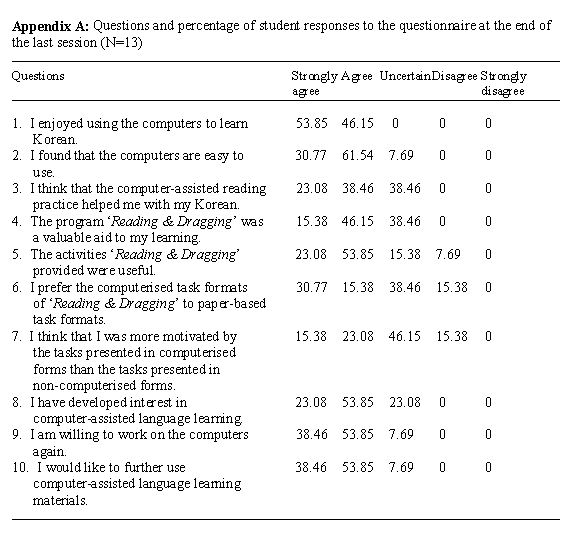
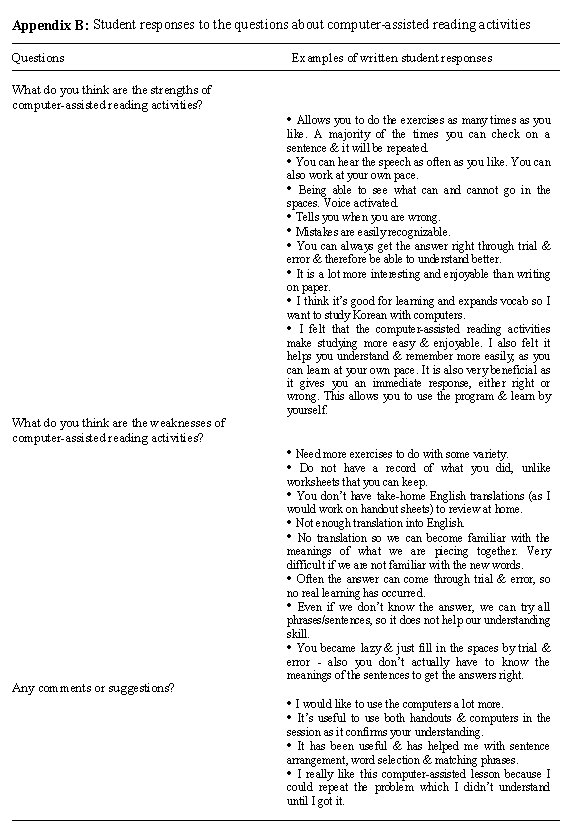
Allegiant Technologies. (1994). SuperCard [Computer program]. San Diego, CA: Author.
Biber, D. (1992). Applied linguistics and computer applications. In W. Grabe & R.B. Kaplan (Eds.), Introduction to applied linguistics (pp. 257-278). Reading, MA: Addison-Wesley.
Buzo, A., & Shin, G.-H. (1995). Learning Korean: New Directions 3. Revised edition. Melbourne: National Korean Studies Centre.
Chapelle, C.A., Jamieson, J., & Park, Y. (1996). Second language classroom research traditions: How does CALL fit? In M.C. Pennington (Ed.), The power of CALL (pp. 33-53). Houston, TX: Athelstan.
Cobb, T., & Stevens, V. (1996). A principled consideration of computers and reading in a second language. In M.C. Pennington (Ed.), The power of CALL (pp. 115-136). Houston, TX: Athelstan.
Edmondson, W., Reck, S., & Schroder, N. (1988). Strategic approaches used in a text-manipulation exercise. In U.O.H. Jung (Ed.), Computers in applied linguistics and language teaching (pp. 193-211). Frankfurt am Main: Verlag Peter Lang.
Evans, M. (1993). Nicolas: Using HyperCard with intermediate level French learners. System, 21, 213-229.
Garrett, N. (1991). Technology in the service of language learning: Trends and issues. Modern Language Journal, 75, 74-101.
Herron, C.A., & Moos, M.A. (1993). Electronic media in the foreign language and literature classroom: A fusion between science and humanities. Foreign Language Annals, 26, 479-490.
Hult, S., Kalaja, M., Lassila, O., & Lehtisalo, T. (1990). HyperReader - An interactive course in reading comprehension. System, 18, 189-198.
Kleinmann, H.H. (1987). The effect of computer-assisted instruction on ESL reading achievement. Modern Language Journal, 71, 267-276.
Li, X. (1996). HyperCharacters: A pilot study in computerized learning of Chinese characters. CALICO Journal, 14(1), 77-94.
Marsh, M. (1983). Computer assisted instruction in reading. Journal of Reading, 26, 697-701.
Nyns, R.R. (1988). Using the computer to teach reading comprehension skills. ELT Journal, 42, 253-261.
Olson, R., & Wise, B. (1987). Computer speech in reading instruction. In D. Reinking (Ed.), Reading and computers: Issues for theory and practice (pp. 156-177). New York: Teacher's College Press.
Piper, A. (1986). Conversation and the computer: A study of the conversational spin-off generated among learners of English as a foreign language working in groups. System, 14, 187-198.
Son, J.-B. (1995). An approach to CALL software for Korean as a foreign language. Korea Observer, 26, 555-578.
Son, J.-B. (1997). An experimental computer-assisted reading practicum in a foreign language classroom. Journal of the Applied Linguistics Association of Korea, 13(1), 35-61.
Stevens, V. (1996). Use and abuse of autonomy in computer-assisted language learning: Some evidence from student interaction with SuperCloze. In R. Pemberton, E. Li, W. Or & H. Pierson (Eds.), Taking control: Autonomy in language learning (pp. 281-302). Hong Kong: Hong Kong University Press.
Windeatt, S. (1986). Observing CALL in action. In G. Leech & C.N. Candlin (Eds.), Computers in English Language Teaching and Research (pp. 79-97). London: Longman.
Wisher, R.A. (1986). Generative approaches to computer-assisted reading instruction. Advances in Reading/Language Research, 4, 97-106.
Wyatt, D.H. (1989). Computers and reading skills: The medium and the message. In M.C. Pennington (Ed.), Teaching languages with computers: The state of the art (pp. 63-78). La Jolla: Athelstan.